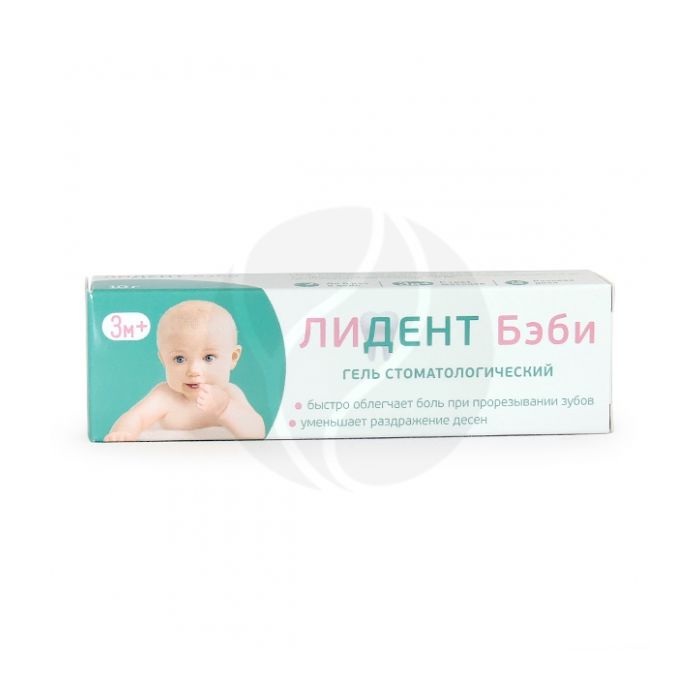Lident Baby gel, 10g
Expiration Date: 11/2025
Russian Pharmacy name:
Лидент Бэби гель, 10г
Infectious and inflammatory diseases of the oral cavity and pharynx:
pharyngitis;
laryngitis;
catarrhal sore throat;
stomatitis;
ulcerative gingivitis;
tonsillitis (as an aid).
Lident Baby is intended for children from 3 months of age.
A small amount of gel (about 7.5 mm) is applied to the tip of a clean finger and gently rubbed into the inflamed area of ??the child's gum. If necessary, the gel can be reapplied at intervals of 20 minutes, but no more than 6 times a day.
Dental gel from light yellow to yellow with a brownish tint; the presence of a weak characteristic odor is allowed.
1 g
lidocaine hydrochloride 3.3 mg
cetylpyridinium chloride 1 mg
Excipients: liquid noncrystallizing sorbitol, xylitol, ethyl alcohol 96%, glycerol, hyetellose (hydroxyethyl cellulose), macrogol glyceryl hydroxystearate (macrogol 40 glyceryl hydroxystearate), lauramacrogol 600-aromatase, sodium macrogol laurylator (E150a), sodium citrate, citric acid, purified water.
I trimester of pregnancy;
breastfeeding period;
hypersensitivity to drug components.
With care Open wounds of the oral mucosa.
pharmachologic effect
Combined for topical use, contains an antiseptic and a local anesthetic.
Cetylpyridinium chloride is an antiseptic from the group of quaternary ammonium compounds; it has bactericidal activity against gram-positive and, to a lesser extent, gram-negative bacteria. Changes the permeability of the cytoplasmic membrane of bacteria, disrupts the internal oxidative mechanisms of respiration of bacteria, which leads to their death. Cetylpyridinium chloride has antifungal and antiviral activity against enveloped viruses.
Lidocaine hydrochloride - a local anesthetic from the group of amides, relieves sore throat in inflammatory processes when swallowing. Lidocaine disrupts the permeability of the cell membrane for sodium ions, which leads to anesthesia as a result of blockade of nerve impulses.
Pharmacokinetics
Cetylpyridinium chloride is practically not absorbed through the oral mucosa.
Lidocaine hydrochloride is poorly absorbed through the oral mucosa. When taken orally, it is absorbed, undergoing metabolism on the 'first pass' through the liver. When taken orally, its bioavailability is about 35%. Metabolites are excreted in the urine, less than 10% of the substance is excreted unchanged.
Side effect
Determination of the frequency of adverse reactions: very often (? 10%); often (? 1%, but? 10%), infrequently (? 0.1%, but? 1%), rarely (? 0.01%, but? 0.1%), very rarely (? 0.01%).
From the digestive system: rarely - nausea; very rarely - diarrhea.
Skin and subcutaneous tissue disorders: very rarely - skin rash, itching.
Local reactions: rarely - local irritation of the oral mucosa and throat.
Application during pregnancy and lactation
Use is contraindicated in the first trimester of pregnancy. Application in the II-III trimesters of pregnancy is possible under medical supervision, if the expected benefit to the mother outweighs the potential risk to the fetus.
Not recommended for use during breastfeeding.
special instructions
Should not be taken immediately before meals or at the same time as milk. Simultaneous intake with milk and food can reduce the local antiseptic and anesthetic effects.
Alcohol increases the absorption of cetylpyridinium chloride, so alcohol should not be consumed during treatment.
Cetylpyridinium chloride slows down wound healing.

